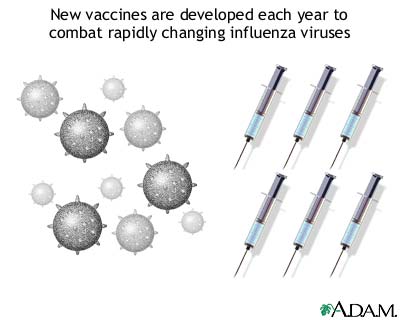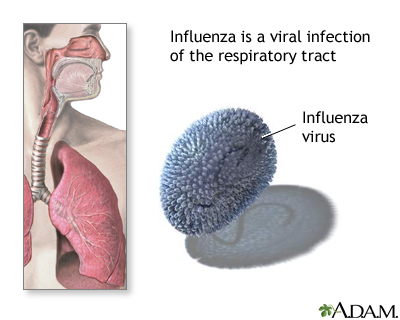Influenza Vaccine
Influenza vaccines

Influenza vaccines are developed each year to protect people from the three strains expected to be most prevalent. All the viruses in the vaccine are killed, so it is not possible to get the flu from the vaccine.
Influenza

Influenza, also known as the flu, is caused by a virus.
This vaccine protects people against the flu.
The flu is a contagious respiratory disease caused by an influenza virus. In the U.S., flu outbreaks typically occur in winter months. Symptoms include fever, chills, sore muscles, and cough. Thousands of people in the U.S. die each year from the flu or its complications. Most of those who die are the elderly, young children, or people with compromised immune systems.
The viruses that typically cause the flu are primarily categorized as influenza type A or type B. Influenza type B does not change much over time, but type A can mutate rapidly. Therefore, a new form of the flu vaccine must be developed each year to protect people for the exact strain that is expected to be most prevalent.
All the influenza viruses in the flu shot are killed (inactive), so it is not possible to get the flu from this type of vaccine. However, some people do experience a low-grade fever for a day or two after the shot as their immune systems gear up to recognize the virus.
A new nasal spray-type flu vaccine called FluMist is proving to be effective and safe in healthy people aged 5 to 49 years old. The FDA-approved vaccine helps the lining of the nose fight off actual viral infections. (FluMist uses a live, weakened virus instead of a dead one like the flu shot.) In one study, the nasal spray provided protection against the flu in up to 93% of children. It is not approved for young children or people with asthma. Flu vaccines are generally given at the beginning of the "flu season" -- usually late October or early November in the U.S. People traveling to other countries should be aware the flu may occur at different times. IMMUNIZATION SCHEDULE According to the U.S. Centers for Disease Control and Prevention, anyone who wants to reduce their risk of the flu can get a flu shot. The flu shot is approved for anyone older that 6 months of age. Some people have a higher risk of the disease. You should be vaccinated each year if you: Children and teenagers receiving long-term aspirin therapy and children between the age of 6 months and 2 years should also receive a flu shot each year. Mercury-free vaccines are preferred in younger children. The flu shot is also recommended for health care providers who work in high-risk settings and direct contacts or caretakers of high-risk individuals. The flu shot is encouraged for: Children under age 9 require two shots one month apart the first time that they receive influenza vaccine. Older children and adults only require a single shot each year.
No comments:
Post a Comment